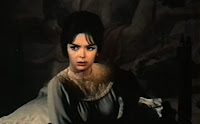A
black screen and some credits, nothing more. I settled comfortably into
my favorite corner of the couch, then…a scream! Not a regular scream
but one that curdles your blood. I spilled some of my popcorn as I
jumped. I looked intently at the screen, the credits continued. That
was the really unsettling thing, a scream without an explanation. The
film opens in a dark, foggy cemetery, as a grave digger is burying a
body. A second man enters the cemetery, and, without warning, knocks the
grave digger unconscious. We see that the deceased is a young woman,
and before any other information can be processed, the stranger reaches
out and caresses her face. Not in a dearly departed way, but in a heavy
breathing, sexually forceful kind of way.
Such
is our introduction to The Horrible Dr. Hichcock, a film about
marriage, medical malpractice, obsession, murder, and necrophilia. I
know, right? You can’t even get a cocktail like that today. Starring
Barbara Steele, Robert Fleming, and Silvano Tranquilli, this film ranks
among the best Italian horror films ever produced. It’s Lynchian and
Hicthcockian, with a pinch of Hammer Horror on a bed of darkness in
which even the daylight scenes seem dark and foreboding.
After
the opening scene we are introduced to Dr. Hichcock hosting a party
with his beautiful wife Margaretha. He gives her a knowing look before
excusing himself. She soon joins him in an underground crypt, and lies
down on a burial bed as if she is dead. The good Dr., meanwhile, is
readying a hypodermic syringe filled with a concoction of his own
making. He shoots her up as she complies, but this time, something goes
wrong. She appears to die. So distraught over the experience, the good
Dr. leaves the country for several years.
So
already within the set up we watch a disturbingly complicit marriage,
treated as if they were swingers or participants in an open marriage. By
that I mean that the fact that she allows him to drug her so that he
can be aroused by her death like state is treated as a matter of fact,
very casually. We are strangely aroused by the whole relationship,
perhaps due to the alluring Maria Teresa Vianello. Regardless of the reason, we are hooked.


After a few years, the Dr. returns to his estate, which has been under the care of his housekeeper, Martha (Harriet White Medin). He has also brought a new wife, Cynthia (Steele), a former patient, who Martha is not very taken with.
Someone
begins tormenting Cynthia, first leaving a human skull in her bed, then
hanging outside her bedroom door wear Margaretha’s shoes as seen in her
large portrait that hangs on the great room wall above the mantle.
As
Cynthia edges toward a psychological breakdown, Dr. Hichcock is
succumbing to his demons, and he is doing so in the morgue!!! Perhaps
because his transgressions are not in our face, we are able to accept
his revolting needs. We do not forgive them or condone them, but we do,
in a way, take them in stride. One person not taking them “in stride” is
the Dr.’s new college, Dr. Lowe (Tranquilli), who has befriended
Cynthia and grows ever the more suspicious of the Doctor. His world is
about to come crashing down around him, and a decades old secret is soon
to reveal itself!
The
film leaves you with a lot to think about and is less than forthcoming
in some areas. Due to time and budgetary constraints, several exposition
scenes were ripped out of the script, but instead of creating an
unwatchable series of scenes, it created a rich and more unnerving film.
For example, the details are left untouched as to whom the veiled woman
is who walks the grounds but the payoff is disturbing and terrifying.
The
film is best described as using many Alfred Hitchcock conventions by
way of David Lynch. It is slow, but engrossing, simple, yet very
convoluted, endearingly romantic in the extreme submissiveness of the
brides. A film that crosses every line in the laws of good taste yet
does so with the utmost respect for its audience. Even though we are
asked to see the film from Hitchcock’s point of view occasionally, we do
it from between our fingers, our hand having been placed over our eyes
by the skill of Director Riccardo Freda.








No comments:
Post a Comment